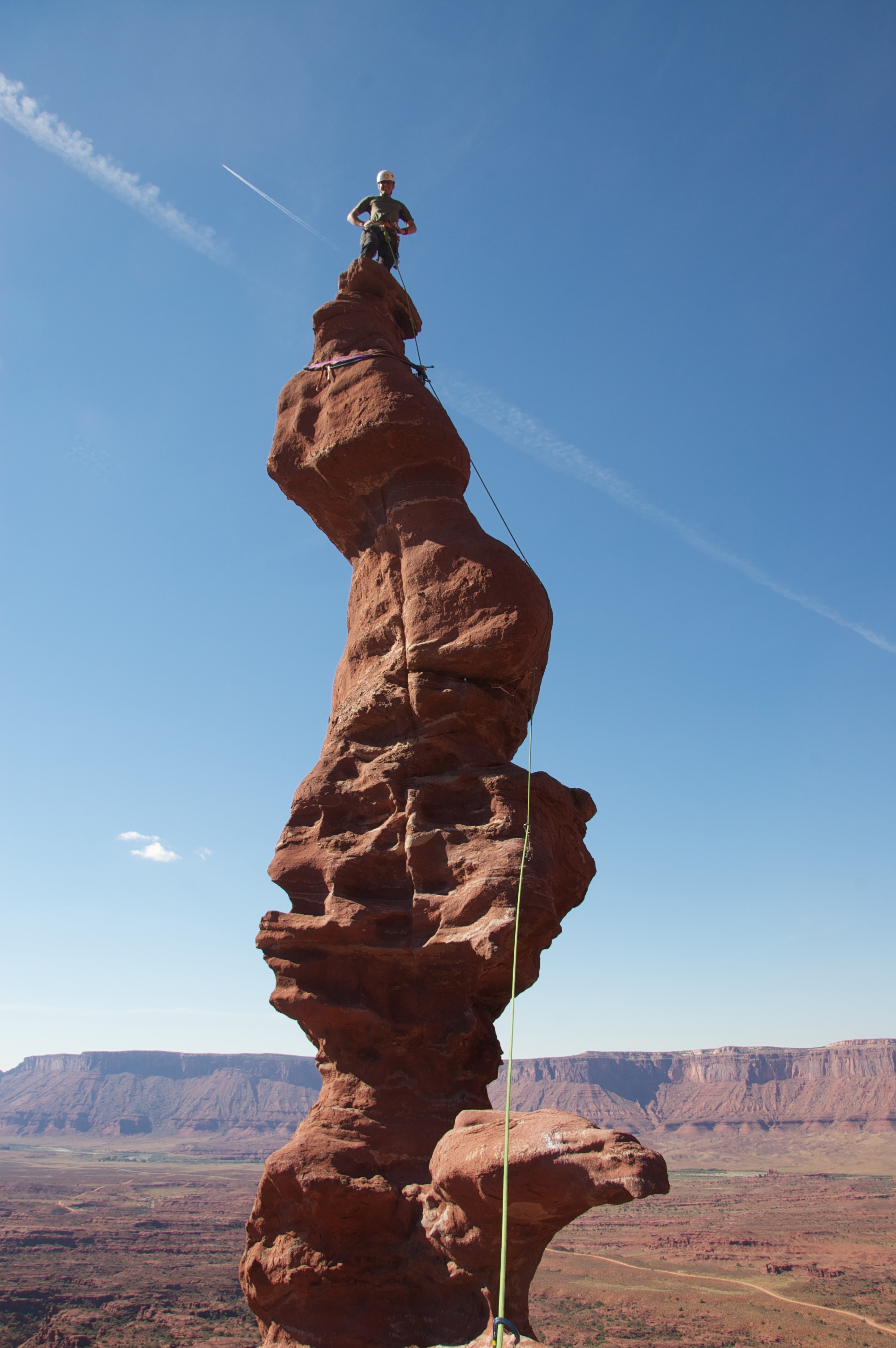|
Federation Peak
Federation Peak is a Tasmanian mountain with a sharp spire-like shape, which marks the end of the Eastern Arthur Range in the Southwest National Park. The peak, approximately south-west from Hobart, was named after the Federation of Australia. With an elevation of above sea level the last stretch of the route up is extremely steep and exposed, involving rockclimbing like moves above Lake Geeves. Its reputation is such that Sir Edmund Hillary declared it "Australia's only real mountain". History The first westerner to sight the peak was the surveyor James Sprent who was carrying out a trigonometrical survey of Tasmania. He described it as "the Obelisk". It became known as Sprent's Obelisk, however in 1901 it was officially named Federation Peak in honour of the Federation of Australia by Thomas Bather Moore while cutting a track from Hastings to Port Davey via Old River. It took almost 50 years after the first western sighting for the summit to be reached, a testament to t ... [...More Info...] [...Related Items...] OR: [Wikipedia] [Google] [Baidu] |
Tasmania
) , nickname = , image_map = Tasmania in Australia.svg , map_caption = Location of Tasmania in AustraliaCoordinates: , subdivision_type = Country , subdivision_name = Australia , established_title = Before federation , established_date = Colony of Tasmania , established_title2 = Federation , established_date2 = 1 January 1901 , named_for = Abel Tasman , demonym = , capital = Hobart , largest_city = capital , coordinates = , admin_center = 29 local government areas , admin_center_type = Administration , leader_title1 = Monarch , leader_name1 = Charles III , leader_title2 = Governor , leader_name2 ... [...More Info...] [...Related Items...] OR: [Wikipedia] [Google] [Baidu] |
Exposure (heights)
Exposure is a climbing and hiking term. Sections of a hiking path or climbing route are described as "exposed" if there is a high risk of injury in the event of a fall because of the steepness of the terrain. If such routes are negotiated without any protection, a false step can result in a serious fall. The negotiation of such routes can cause fear of falling because of the potential danger. Definitions What constitutes exposure on a path is fairly obvious, however, an "exposed" location or section of a climbing route is not uniformly or clearly defined in the literature. There are no threshold values, for example, based on the gradient of the terrain, the height of rock faces or the character of a ridge or arête. Authors tend to use their own definition of the terms "exposure" or "exposed" when describing routes, for example: Exposure * "''The distance from the climber to where the climber would likely stop in the event of an unprotected fall.''" * "''Being very far above ... [...More Info...] [...Related Items...] OR: [Wikipedia] [Google] [Baidu] |
List Of Highest Mountains Of Tasmania
The Australian island state of Tasmania has a diverse range of geography but a prominent feature is the mountains of the island. Overall Tasmania is comparatively low-lying with the highest point at . Tasmania has ten peaks over the height of . With thirty peaks higher than , it is one of the most mountainous islands in the world, and Tasmania is Australia's most mountainous state. The majority of the mountain peaks of Tasmania are located in the Western half of the state, starting at the coast in the South West and extending inland to the north, or in the Central Highlands. Tasmania's mountains were part of an ancient range of volcanic peaks from the period of Gondwana, and are the source of a large portion of Tasmania's wealth in the form of mining. Although the eastern half of the state is generally lower and flatter, there are still sizeable peaks located there, such as kunanyi / Mt Wellington. Notable peaks The following notable mountain peaks in Tasmania range in ... [...More Info...] [...Related Items...] OR: [Wikipedia] [Google] [Baidu] |
Scotts Peak
Scotts Peak Scotts Peak is a mountain in South West Tasmania which is associated with the construction and flooding of the original Lake Pedder, as the lake now completely surrounds the peak. It lies east of the Frankland Range and has an elevation of 669 metres. There is a Scotts Peak Dam and a Scotts Peak Dam Road in the region. Scotts Peak is accessible by Scotts Peak Dam Road and the Lake Pedder Lake Pedder, once a glacial outwash lake, is a man-made impoundment and diversion lake located in the southwest of Tasmania, Australia. In addition to its natural catchment from the Frankland Range, the lake is formed by the 1972 damming of the ... boat ramp. Many people kayak across the reservoir to hike Scotts Peak. Climate Further reading *(1990) ''Draft recreation development plan : Strathgordon - Scotts Peak area''. Hobart, Tas. : Department of Parks, Wildlife and Heritage. References * * Mountains of Tasmania South West Tasmania Lake Pedder {{Australia- ... [...More Info...] [...Related Items...] OR: [Wikipedia] [Google] [Baidu] |
Geeveston, Tasmania
Geeveston is a small town in the south of Tasmania in Australia on the Huon River, south west of Hobart, making it Australia's most southerly administrative centre. The town takes its name from William Geeves, an English settler who was given a land grant by Lady Jane Franklin in the area then known as Lightwood Bottom (after a type of timber prevalent in the area). The settlement Geeves set up was renamed Geeves Town in 1861, and the name eventually became Geeveston.Geeveston '''', February 8, 2004. Geeveston is for local government purposes included in the area of the |
Bushwalkers
Hiking is a long, vigorous walk, usually on trails or footpaths in the countryside. Walking for pleasure developed in Europe during the eighteenth century.AMATO, JOSEPH A. "Mind over Foot: Romantic Walking and Rambling." In ''On Foot: A History of Walking'', 101-24. NYU Press, 2004. Accessed March 1, 2021. http://www.jstor.org/stable/j.ctt9qg056.7. Religious pilgrimages have existed much longer but they involve walking long distances for a spiritual purpose associated with specific religions. "Hiking" is the preferred term in Canada and the United States; the term "walking" is used in these regions for shorter, particularly urban walks. In the United Kingdom and the Republic of Ireland, the word "walking" describes all forms of walking, whether it is a walk in the park or backpacking in the Alps. The word hiking is also often used in the UK, along with rambling , hillwalking, and fell walking (a term mostly used for hillwalking in northern England). The term bushwalking is ende ... [...More Info...] [...Related Items...] OR: [Wikipedia] [Google] [Baidu] |
Rock Climbing
Rock climbing is a sport in which participants climb up, across, or down natural rock formations. The goal is to reach the summit of a formation or the endpoint of a usually pre-defined route without falling. Rock climbing is a physically and mentally demanding sport, one that often tests a climber's strength, endurance, agility and balance along with mental control. Knowledge of proper climbing techniques and the use of specialized climbing equipment is crucial for the safe completion of routes. Because of the wide range and variety of rock formations around the world, rock climbing has been separated into several different styles and sub-disciplines, such as scrambling, bouldering, sport climbing, and trad (traditional) climbing another activity involving the scaling of hills and similar formations, differentiated by the rock climber's sustained use of hands to support their body weight as well as to provide balance. Rock climbing competitions have the objectives of either ... [...More Info...] [...Related Items...] OR: [Wikipedia] [Google] [Baidu] |
The Geelong College
, motto_translation = Thus one goes to the stars , established = , type = Independent, co-educational, day and boarding, Christian school , denomination = in association with the Uniting Church , slogan = , principal = Peter Miller , chaplain = Stephen Wright , founder = Alexander James Campbell , key_people = , city = Newtown , state = Victoria , country = Australia , coordinates = , gender = Co-educational , enrolment = 1,200-1,300 (K–12) , num_employ = , colours = , affiliation = Associated Public Schools of Victoria , website = The Geelong College is an Australian independent and co-educational, Christian day and boarding school located in Newtow ... [...More Info...] [...Related Items...] OR: [Wikipedia] [Google] [Baidu] |
Roaring Forties
The Roaring Forties are strong westerly winds found in the Southern Hemisphere, generally between the latitudes of 40°S and 50°S. The strong west-to-east air currents are caused by the combination of air being displaced from the Equator towards the South Pole, the Earth's rotation, and the scarcity of landmasses to serve as windbreaks at those latitudes. The Roaring Forties were a major aid to ships sailing the Brouwer Route from Europe to the East Indies or Australasia during the Age of Sail, and in modern times are favoured by yachtsmen on round-the-world voyages and competitions. The boundaries of the Roaring Forties are not consistent: The wind-stream shifts north or south depending on the season. The strong and continuous winds in the Roaring Forties make this zone highly prospective for wind power such as in New Zealand and Tasmania. Similar but even stronger conditions that occur at more southerly latitudes are called the Furious Fifties and the Shrieking or Screa ... [...More Info...] [...Related Items...] OR: [Wikipedia] [Google] [Baidu] |
James Sprent
James Sprent (1808 – 22 September 1863) was a Surveyor General of Tasmania, (then the colony of Van Diemen's Land, now a state of Australia). Early life Sprent was born in Manchester, England and was educated at Glasgow University (M.A., 1825) and St John's College, Cambridge. Career in Australia In May 1830 Sprent arrived in Van Diemen's Land (later renamed Tasmania). He opened a school for boys that year, offering classes in Latin, Mathematics and French. Two years later, he extended this offering to young ladies and adult after school hours. Surveying Work After he was refused a free land grant in 1833, Sprent was appointed temporary assistant surveyor, closed his academy and began work on a trigonometrical survey - inspired by the Great Trigonometrical Survey of India. Sprent and Calder located and cleared 50 mountaintop stations across the east of the state, leaving markers visibile from a distance, before work was suspended due to budget cuts in 1837. He was subsequent ... [...More Info...] [...Related Items...] OR: [Wikipedia] [Google] [Baidu] |
Australian Height Datum
The Australian Height Datum was introduced in 1971 as the official vertical datum for Australia, and thereby serves as the benchmark to which all height measurements are referred. The Australian Height Datum is an amalgamation of decades of spirit levelling work conducted by numerous state and territory authorities across the country, and was corrected to align with the mean sea level observations of thirty tide gauges positioned around the entire coastline. While it remains the published vertical datum for all surveying and engineering operations performed throughout Australia, newer technologies have uncovered numerous deficiencies, offsets and distortions within the Australian Height Datum, leading to discussions about defining a new Australian vertical datum. Background The National Mapping Council (pre-1945) Prior to the creation of the Australian Height Datum, levelling surveys were carried out by professional surveyors for construction and mapping purposes using only ... [...More Info...] [...Related Items...] OR: [Wikipedia] [Google] [Baidu] |
Australia
Australia, officially the Commonwealth of Australia, is a Sovereign state, sovereign country comprising the mainland of the Australia (continent), Australian continent, the island of Tasmania, and numerous List of islands of Australia, smaller islands. With an area of , Australia is the largest country by area in Oceania and the world's List of countries and dependencies by area, sixth-largest country. Australia is the oldest, flattest, and driest inhabited continent, with the least fertile soils. It is a Megadiverse countries, megadiverse country, and its size gives it a wide variety of landscapes and climates, with Deserts of Australia, deserts in the centre, tropical Forests of Australia, rainforests in the north-east, and List of mountains in Australia, mountain ranges in the south-east. The ancestors of Aboriginal Australians began arriving from south east Asia approximately Early human migrations#Nearby Oceania, 65,000 years ago, during the Last Glacial Period, last i ... [...More Info...] [...Related Items...] OR: [Wikipedia] [Google] [Baidu] |





.jpeg)
